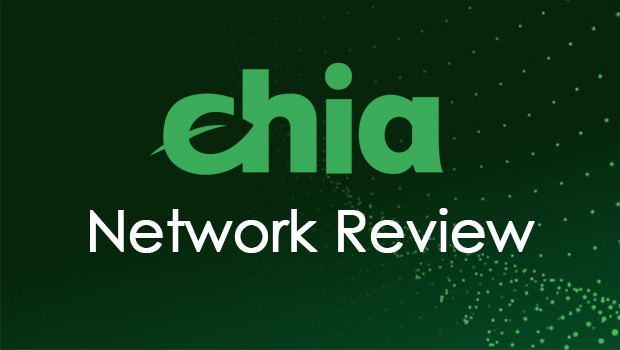You’ve heard about Chia before – some say it’s the new gold mine, others label it just another shitcoin and move on.
Unlike certain sensationalists out there, I took the time to follow and study the project for a bit before I decided to write this review. Hopefully, it will help you to better understand whether Chia is for you.
This is going to be part of my Chia series where I will be testing different hardware, and assembling Chia farming and plotting rigs, so if you’re interested in that, make sure to follow me.
What is Chia? The Basics
Chia is a new coin that aims to solve some of the issues we have with most of the currently used cryptocurrencies. Namely, the main aim of Chia is to move away from both Proof-of-Work and Proof-of-Concept models into a totally new territory.
Chia coin introduces a new concept – Proof of Space and Time (POST). It is meant to be way greener than POW, as well as more secure than POS. Unlike POW, POST is also meant to make mining more accessible for the average Joe since it requires storage space instead of raw hashing power. And by being less power-hungry, Chia mining should in theory be profitable even for those of us living in areas with expensive electricity.
POST vs. POW
The issue with proof of work is that it’s not eco-friendly at all. The amount of energy used worldwide by Bitcoin miners alone stands close to what a small country consumes. A lot of POW coins also struggle with centralization issues – we see more and more hashrate coming from huge mining farms with specialized equipment.
Proof of space, on the other hand, utilizes hard drive storage space. Unlike other projects like SIA and Storj, Chia does not offer decentralized storage. Instead, it’s basically CPU mining that requires a bit of CPU power and a lot of free storage to validate transactions on the network.
To prevent grinding attacks like on Burstcoins, Chia also implemented a proof-of-time concept. Plotting takes quite a lot of time and work, and that has been implemented on purpose to prevent people from abusing the system through constant plot overriding.
Chia Features
Chia was created by Bram Cohen of BitTorrent Fame. It is written in Chialisp, a lisp-like language. Just like Ethereum, it allows smart contracts. The Chia wallet already supports atomic swaps and multisig. Users can also build their own cryptocurrencies based on Chia called ‘Color Coins’. Users can then create their own rules how those coins work, and peg them to real world and/or assets, use them for reward schemes, etc.
Chia Plotting and Farming
Unlike most other minable coins, Chia mining consists of two parts:
- The first one is called ‘Plotting’. Plotting is the process of assigning a certain part of your hard drive to the Chia network. It’s a process that takes 5-15 hours per plot (depending on your drive speed and setup).
- The second part is called ‘Farming’. Every 10 minutes, 32 active plots are randomly selected to be allowed to mine 2 Chia tokens. Just like with Bitcoin, these rewards will be halved every 3 years until they reach a hard cap of 4 Chia every 10 minutes.
Note: Chia mining was labeled as ‘farming’ by its devs to empathize the eco-friendly nature of the coin, as well as to prevent it from being associated with the less and less loved word ‘mining’. In reality though, the therm ‘mining’ is still technically correct, and the word ‘farming’ is just flair.
Chia Mining Hardware Requirements
In theory, Chia can be mined/famed on virtually any PC that has at least 250 GB free storage space. Even though every plot takes about 100GB of space, the plotting process requires you to have a headroom of about 250 GB. There are no minimum requirements regarding CPU power, as long as it’s not a totally outdated model.
While this sounds simple enough on paper, the reality is obviously a bit more complex (Just a bit, I promise!… with my fingers crossed behind my back). Here are some things you need to know before farming Chia:
-
Hard Drive Speed Matters a LOT
Slow hard drives offer slow plot times, which translates into less profits.
In POW mining, we have something called hashrate, and the more a piece of mining gear hashes, the more profit it brings. Chia mining is the same, except that what counts is drive speed rather than computational power.
Now, as we know, the speed of a drive is determined by the drive itself, its connection type (SATA, PCIe, etc), as well as the motherboard port types. This means that ultimately, Chia mining speed still varies depending on the used gear, and the differences might be huge.
Here is a list with what most of the users use to create Chia plots (i wil have my own list of NVMe ssds in the next article):
-
You’ll Need A TON of Plots
At the time I am writing this, the average chances for one plot of finding a block are very thin. According to the calculator built into the official Chia farming software, the average time it will take one plot to hit the jackpot is 13 years. This number can easily double in the next month as more miners join.Basically, if you want to get any sort of profit off of Chia mining, you’d need at least 40-50 TB worth of high-speed storage.
-
Chia Farming Kills Consumer-Grade SSDs
If you’re planning on mining on your gaming PC, Chia plotting can easily kill your SSD drive. During the plotting process, the drive has to read and write terabytes worth of information. If you don’t know already, every solid state drive has its write limit (called TBW). Basically, there is a certain amount of information the SSD can handle before it dies.
Chia farming will kill most consumer-grade SSD’s pretty fast. Most of the drives won’t last more than two months. An expensive enterprise-grade drive however might survive Chia mining for up to two years.
-
You Might Need a Dedicated Chia Plotting Rig
With how long it takes to create one single plot, the Chia miner software offers you the option to create several plots in parallel. While this comes in handy if you have several drives connected to your PC, creating more than one plot at a time applies a considerable load on your CPU and RAM usage.
Having all of that in mind, if you want to have a chance of profiting off farming Chia, you might want to get a dedicated Chia mining rig with enterprise-grade SSDs, decent CPU and RAM.
This is what i am using right now for plotting Chia, in the next article i will have a more detailed list for both budget and high end plotting and farming rig:
Chia Mining Competition and Possible Issues
The mining landscape is shaped by the amount and size of active miners. Ideally, home miners should be only competing with other home miners but it proved to not be the case with POW coins. Most POW coins are dominated by big companies that own huge mining farms, and take advantage of regions with cheap or free electricity.
Chia mining is not power-intensive, so that’s a plus. As a downside, a lot of the existing data centers all around the globe can easily become Chia mining farms. Server-grade storage drives are perfect for Chia mining thanks to their high access speed and durability.
If you’re mining at home, you might want to get into the project asap before the network gets too saturated. There’s a catch, though:
Chia Pool Mining
Yes, that amazing thing called ‘pool mining’ isn’t yet officially available for Chia. Why is it important?
Just like with conventional GPU and ASIC mining, there is a fixed amount of coins mined every day, and the more units mine the coin, the lesser are the chances for each of them to get the reward.
Now, since Chia does not have any official mining pools, everyone has to solo mine. This is what produces the lottery ticket effect – as a miner, instead of a constant slow stream of cryptos that’s based on your plot count, every tick you either get nothing or two entire Chia tokens (XCH), purely based on luck. While adding more plots increases your odds, there is always that chance that someone with one plot comes and shamelessly steals the jackpot.
Currently, only community pools are available for use but they don’t seem to be reliable. Official pools are planned to be released next month.
In Conclusion
Chia is a new cryptocurrency is gaining a lot of traction. It has been listed on exchangers very recently, and over the past month, the list of exchangers the coin could be bought from expanded from 3 to 17. With its price currently hovering between the 600 and 700 dollar mark per coin, Chia is one of the coins that might be worth mining, at least until big storage providers step into the game.
I am working on several guides on how to farm Chia efficiently, so stay tuned! Next one will be about the best hardware for plotting Chia.
Subscribe below to get notified instantly when new Chia related articles are published
Chia useful links:
Official website: https://www.chia.net/
Forum: https://chiaforum.com/
Farming Calculator: https://chiacalculator.com/
Disclaimer: This is not financial advise, I am not a financial advisor, this is for educational purposes only. If you want to invest in cryptocurrency please do your own research and invest at your own risk, 1stMiningRig is never liable for any decisions you make. 1stMiningRig may receive donations or sponsorships in association with certain content creation. 1stMiningRig may receive compensation when affiliate/referral links are used.
Thank you for reading. As always, your comments, suggestions and questions are welcome.
Subscribe and stay tuned for further updates!










